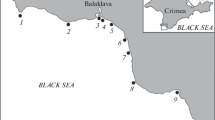Summary
The red tide alga,Chattonella antiqua, was found to show a strong chemiluminescence, using luminol as the reagent, when exposed to ultraviolet irradiation. This luminescence was completely inhibited by ascorbate or catalase, suggesting that hydrogen peroxide was generated by the plankton. Red tide cells exposed to fish gill mucus from young yellowtail resulted in the release of a large number of mucocysts and a weak luminosity, and showed a strong reduction of cytochromec in the medium. Therefore, the discharge of mucocysts from the red tide, induced by the presence of gill mucus, may be accompanied by the release of active oxygen species. The active oxygen may be involved in depolymerization of mucus glycoproteins from the gill lamellae.
Similar content being viewed by others
References
Beauchamp, C. &Fridovich, I. (1970) A mechanism for the production of ethylene from methional. The generation of the hydroxy radicals by xanthine oxidase.J. Biol. Chem. 245, 4641–6.
Bray, R. C. &Cockle, S. A. (1974) Reduction and inactivation of superoxide dismutase by hydrogen peroxide.Biochem. J. 139, 43–8.
Chance, B., Sies, H. &Boveris, A. (1979) Hydroperoxide metabolism in mammalian organs.Physiol. Rev. 59, 527–605.
Cooper, B., Creeth, M. &Donald, A. S. R. (1985) Studies of the limited degradation of mucus glycoproteins.Biochem. J. 228, 615–26.
Doi, A., Hatase, O., Shimada, M., Murakami, T. H. &Okaichi, T. (1981) Ultrastructural changes in gill epithelia of a yellowtail,Seriola quinqueradiata, exposed to sea bloom.Cell. Str. Func. 6, 375–83.
Gilbert, B. C., King, D. M. &Thomas, C. B. (1984) The oxidation of some polysaccharides by the hydroxyl radical: an e.s.r. investigation.Carbohydr. Res. 125, 217–35.
Haber, F. &Weiss, J. (1934) The catalytic decomposition of hydrogen peroxide by iron salts.Proc. Roy. Soc. Lond. Ser. A. 147, 332–51.
Hayami, M., Tsujimoto, H., Komuro, A., Hinuma, Y. &Fujiwara, K. (1984) Transmission of adult t-cell leukemia virus from lymphoid cells to non-lymphoid cells associated with cell membrane fusion.Gann 75, 99–102.
McCord, J. M. (1974) Free radicals and inflammation: Protection of synovial fluid by superoxide dismutase.Science 185, 529–31.
McCord, J. M. &Fridovich, I. (1969) Superoxide dismutase. An enzymic function for erythrocuprein (hemocuprein).J. Biol. Chem. 244, 6049–55.
McCord, J. M., Keele, B. B. Jr. &Fridovich, I. (1971) An enzyme-based theory of obligate anaerobiosis: The physiological function of superoxide dismutase.Proc. Natl Acad. Sci. USA 68, 1024–7.
Murray, H. W., Rubin, B. Y., Carriero, S. M., Harris, A. M. &Jaffee, E. A. (1985) Human mononuclear phagocyte antiprotozoal mechanisms: Oxygen-dependent vs oxygen-independent activity against intracellular toxoplasma gondii.J. Immunol. 134, 1982–8.
Nakayama, T., Kaneko, M., Kodama, M. &Nagata, C. (1985) Cigarette smoke induces DNA single-strand breaks in human cells.Nature 314, 462–4.
Roberts, C. R., Mort, J. S. &Roughley, P. J. (1987) Treatment of cartilage proteoglycan aggregate with hydrogen peroxide.Biochem. J. 247, 349–57.
Shimada, M., Murakami, T. H., Doi, A., Abe, S., Okaichi, T. &Watanabe, M. (1982) A morphological and histochemical study on gill primary lamellae of the teleost,Seriola quinqueradiata, exposed to sea bloom.Acta Histochem. Cytochem. 15, 497–507.
Shimada, M., Murakami, T. H., Imahayashi, T., Ozaki, H. S., Toyoshima, T. &Okaiche, T. (1983) Effects of sea bloom,Chattonella antiqua, on gill primary lamellae of the young yellowtail,Seriola quinqueradiata.Acta Histochem. Cytochem. 16, 232–44.
Shimada, M., Shimono, R., Imahayashi, T., Ozaki, H. &Murakami, T. H. (1986) Diazo-reaction positive substance observed in the cortex ofChattonella antiqua.Histol. Histopath. 1, 327–33.
Shimada, M., Shimono, R., Murakami, T. H., Yoshimatsu, S. & Ono, C. (1989) Red tide,Chattonella antiqua reduces cytochrome c from horse heart.Red tides: biology, environmental science, and toxicology (edited byT. Okaichi, D. M. Anderson & T. Nemoto) pp. 443–6.
Toyoshima, T., Ozaki, H. S., Shimada, M., Okaichi, T. &Murakami, T. H. (1985) Ultrastructural alterations on chloride cells of the yellowtail,Seriola quinqueradiata, following exposure to the red tide species,Chattonella antiqua.Marine Biology 88, 101–8.
Author information
Authors and Affiliations
Rights and permissions
About this article
Cite this article
Shimada, M., Akagi, N., Nakai, Y. et al. Free radical production by the red tide alga,Chattonella antiqua . Histochem J 23, 361–365 (1991). https://doi.org/10.1007/BF01042181
Received:
Revised:
Issue Date:
DOI: https://doi.org/10.1007/BF01042181




